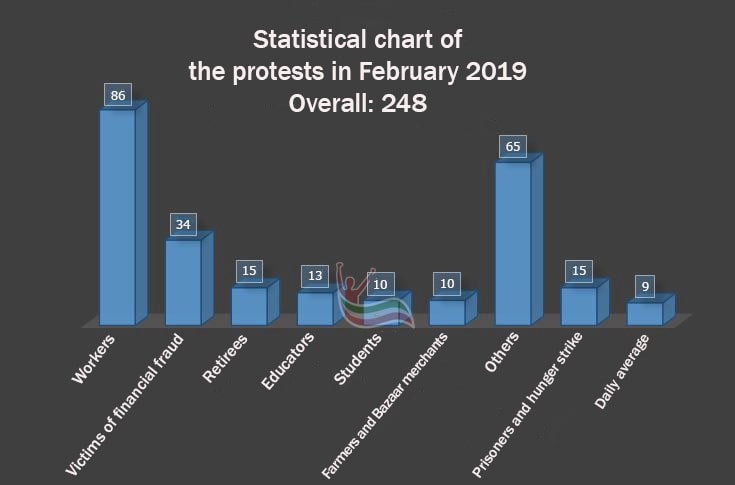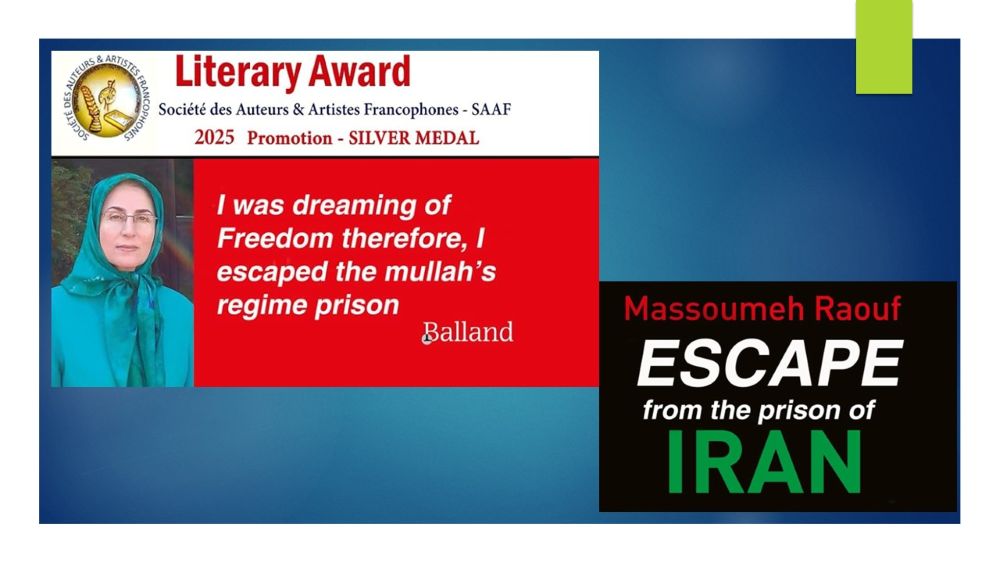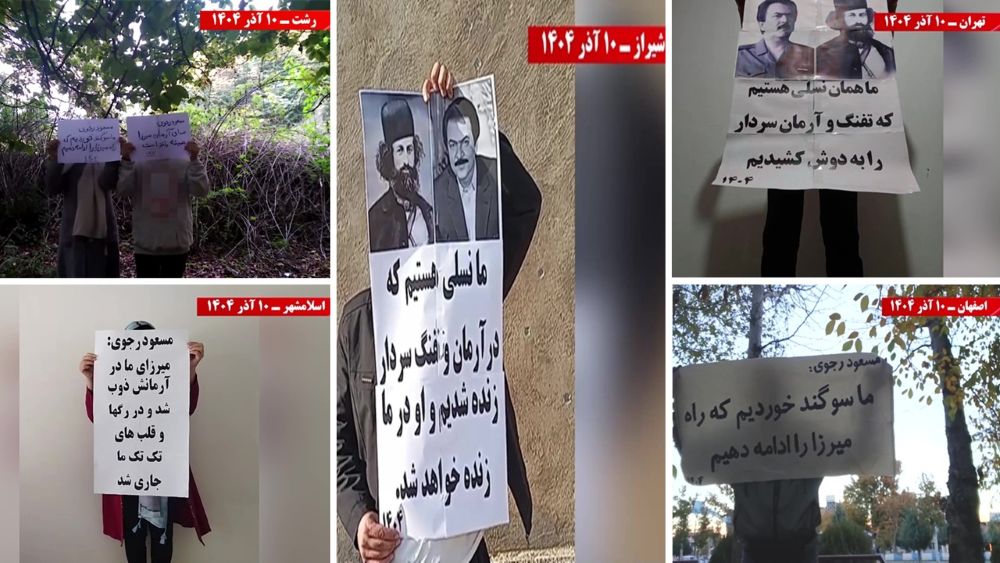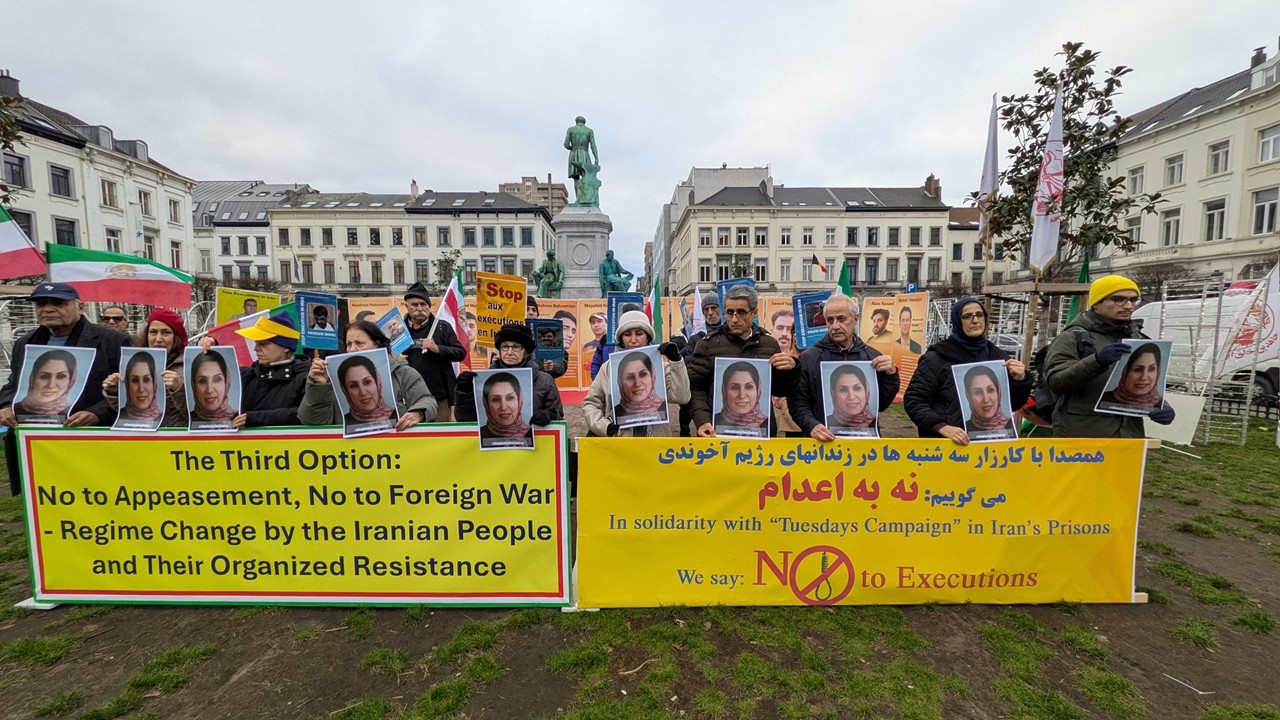Report of Iran’s protests in February 2019
Iran’s protests in February 2019, turned into one of the greatest problems for the Iran regime. Despite the Iran regime’s all-out attempts to quell the protests in February 2019, according to the reports, 248 protests took place in 71 cities, rural communities, industrial districts, trade centers, and so on. On average, there were 9 protests a day.
Statistical report of Iran’s protests in February 2019:
- Overall: 248
- Workers 86
- Retirees 15
- Educators 13
- Students 10
- Farmers and bazaar merchants 10
- Prisoners and prisoners’ hunger strike 15
- Others 65
Statistical chart of Iran’s protests in February 2019

The thematic report of Iran’s protests in February 2019:
In February 2019, we witnessed 86 workers’ protest gatherings in 38 cities, trade centers and industrial districts, on average, 3 protests a day.
The protests were held against unpaid wages, premiums, and other non-payments from several months to one and a half years, inequality in wages, privatization, layoff plans, dismissals, the dire livelihood, and shutting down the companies and factories.
The most important protests of the workers in February were as follow:
– The municipalities’ workers staged protest gatherings in the cities of Tabriz, Borujerd, Weiss, Parsabad Moghan, Ahvaz, Shadegan, Bandar Khomeini, Chabahar, Zanjan, Khorramabad, Bostan, Sarv-Abad, Kermanshah, Tohid, and Abezhdan, for several days.
– Railway workers in cities of Karaj, Shahrood, Tabriz, Ahmadabad, Ajabshir, Marand, Jolfa, and Andimeshk went on strike for several days.
– Ahvaz Urban Train workers held protest gatherings for several days.
– The workers of Golnaz Vegetable Oil factory, in Kerman City, held protest gatherings for several days.
– The workers of Jahan Vegetable Oil factory, in Zanjan City, held protest gatherings for several days.
Plundered customers of regime affiliated financial institutes:
The plundered customers of the regime-affiliated financial institutes held 34 protest gatherings in 8 cities as follow:
- In February, plundered customers of Caspian Credit Institution (in the cities of Rasht, Tehran, Nishapur, Ilam, Kermanshah, and Mashhad), Dehkadeh Abi Pars (Garmdareh, Alborz Province), Sekkeh Samen Site in Tehran, Meftah Rahnavard Co. in Tehran, Badre Tous (Mashhad), Shadi jewelry store in Tehran, ADAK Khodro In Tehran, Padideh Shandiz Institution (in Mashhad and Tehran), Persian Pars Co. in Tehran, and Automobile buyers in Tehran, staged protest gatherings.
Retirees:
Retirees held 15 protest gatherings in 3 cities. The most important protests of the retirees in February were as follow:
– The protest gathering of retired workers of Haft-Tappeh Sugar Cane Co. for 3 consecutive day and nights in Susa.
– The pre-announced protest gatherings of civil and army retirees, twice a week in front of Majlis (Parliament), in Tehran.
Educators:
The educators held 13 protest gatherings in 12 cities. They protested against the non-fulfillment of their demands and unpaid salaries.
In February, the educators held pre-announced protest gatherings in front of the province’s General Office of Education, in the cities of Ardebil, Orumiyeh, Khorramabad, Sanandaj, Kermanshah, Mashhad, Shiraz and Marivan.
Students:
Students staged 10 protest gathering in four cities; the most important students’ protests were:
- The students of Azad University, Science and Research Branch, protested on the 40th day of the death of 11 students, killed in a bus accident, against the negligence of the authorities which led to the event.
- Dental Students in Bandar Abbas, Hormozgan Province gathered to protest the lack of medical and educational services.
- The gathering of the Sharif University students to protest against militarization the universities.
Farmers:
The farmers staged 5 protest gatherings in four cities as follow:
- Oshkohran village’s farmers, Isfahan Province, held a gathering to protest the lack of proper irrigation of their agricultural lands.
- Farmers of Dana in Kohgiluyeh and Boyer-Ahmad Province, staged a gathering, protesting to the improper distribution of chemical fertilizers.
- Farmers in Khorasgan, Isfahan Province, gathered in protest to the usurpation of their water rights by the government agencies.
- Farmers in Naghadeh, West Azarbaijan Province, staged a protest gathering for not receiving several months of wages from the city’s sugar factory.
Bazaar merchants staged 5 protest gatherings in two cities as follow:
– Mobile marketers in Allaedin Bazaar in Tehran went on strike to protest to high prices and the market depression on the eve of the New Year.
– Anbarabad marketers staged a gathering to protest setting up a fair that has overshadowed their businesses.
Others:
In February 2019, there were 65 more protest gatherings in 23 cities. The most important protests were as follow:
– The family of Ismail Bakhshi, a detained labor activist, together with a group of workers, gathered for several days, in protest to not releasing him.
– The families of the victims of Tehran-Yasuj plane crash staged a protest gathering.
– The employees of Firefighting Organization in Abadan (S.W.) staged protest gatherings.
– The quake-stricken people in Sar-e-Pol-e Zahab (W.) staged a gathering to protest the power cut in Neshat Park camp, the lodging of the quake-stricken people.
– The resident of Khalifeh-ye Heydar village, Khuzestan Province, staged a gathering to protest the hiring non-locals by Haft Tappeh Sugar Cane Company.
– A number of unemployed youths in Asalouyeh, Bushehr Province, held a gathering protest against not being hired in the Asalouyeh’s contract projects.
– The unemployed youth of Moshrageh District, Khuzestan Province, staged a gathering to protest against not hiring the local people in oil stations and oil drilling in the region.
– People of Taraqeh and Nowbar villages in Bukan County, West Azerbaijan Province, staged a gathering to protest against not hiring them in the district’s mines.
– The graduated dental care professionals held a protest gathering in front of the Health Ministry.
– A group of individuals taking law exams, in Tehran, gathered to demand an increase in admittance in 2019.
– The graduated students of engineering staged a gathering in Tehran to protest to not being hired by the Ministry of Roads and Urban Development.
– A number of conservationists gathered by Zayandeh Rood River in Isfahan, to protest against the cutting off the water current in the river.
– The employees of the Saham-e Edalat offices staged gatherings in Tehran in protest to the lack of job security.
Conclusion: Because of the regime’s surging crises, as the result of devastation domestic and regional policies, the economic pressure on the Iranian people is increasing. The skyrocketing high costs of livelihood and the extensive poverty have become intolerable; while the regime’s officials are involved in large-scale plundering of the nation’s wealth.
Non-payment of workers’ wages, employees and particularly the educators’ salaries, have driven more and more people to the below of the poverty line. A looking at Iran’s protests in February 2019 shows that the regime is caught in a tough situation and the development of the protests can initiate an outstanding uprising.
This report originally published in the Our Iran website in Persian



